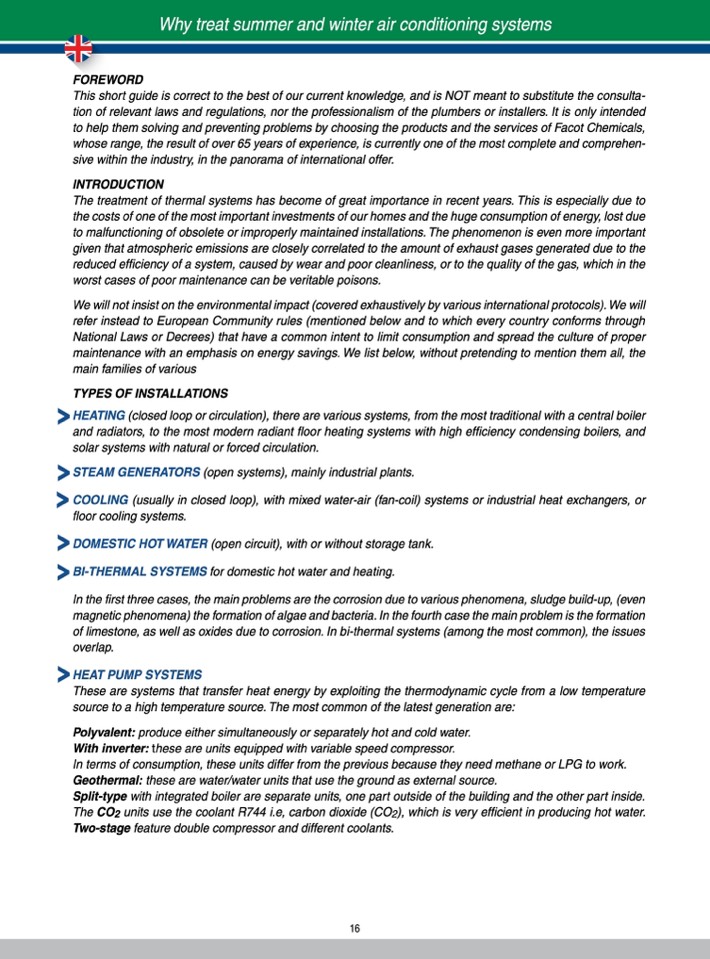
Why treat summer and winter air conditioning systems
FOREWORD
This short guide is correct to the best of our current knowledge, and is NOT meant to substitute the consulta-
tion of relevant laws and regulations, nor the professionalism of the plumbers or installers. It is only intended
to help them solving and preventing problems by choosing the products and the services of Facot Chemicals,
whose range, the result of over 65 years of experience, is currently one of the most complete and comprehen-
sive within the industry, in the panorama of international offer.
INTRODUCTION
The treatment of thermal systems has become of great importance in recent years. This is especially due to
the costs of one of the most important investments of our homes and the huge consumption of energy, lost due
to malfunctioning of obsolete or improperly maintained installations. The phenomenon is even more important
given that atmospheric emissions are closely correlated to the amount of exhaust gases generated due to the
reduced efficiency of a system, caused by wear and poor cleanliness, or to the quality of the gas, which in the
worst cases of poor maintenance can be veritable poisons.
We will not insist on the environmental impact (covered exhaustively by various international protocols). We will
refer instead to European Community rules (mentioned below and to which every country conforms through
National Laws or Decrees) that have a common intent to limit consumption and spread the culture of proper
maintenance with an emphasis on energy savings. We list below, without pretending to mention them all, the
main families of various
TYPES OF INSTALLATIONS
HEATING (closed loop or circulation), there are various systems, from the most traditional with a central boiler
and radiators, to the most modern radiant floor heating systems with high efficiency condensing boilers, and
solar systems with natural or forced circulation.
STEAM GENERATORS (open systems), mainly industrial plants.
COOLING (usually in closed loop), with mixed water-air (fan-coil) systems or industrial heat exchangers, or
floor cooling systems.
DOMESTIC HOT WATER (open circuit), with or without storage tank.
BI-THERMAL SYSTEMS for domestic hot water and heating.
In the first three cases, the main problems are the corrosion due to various phenomena, sludge build-up, (even
magnetic phenomena) the formation of algae and bacteria. In the fourth case the main problem is the formation
of limestone, as well as oxides due to corrosion. In bi-thermal systems (among the most common), the issues
overlap.
HEAT PUMP SYSTEMS
These are systems that transfer heat energy by exploiting the thermodynamic cycle from a low temperature
source to a high temperature source. The most common of the latest generation are:
Polyvalent: produce either simultaneously or separately hot and cold water.
With inverter: these are units equipped with variable speed compressor.
In terms of consumption, these units differ from the previous because they need methane or LPG to work.
Geothermal: these are water/water units that use the ground as external source.
Split-type with integrated boiler are separate units, one part outside of the building and the other part inside.
The CO2 units use the coolant R744 i.e, carbon dioxide (CO2), which is very ef
ficient in producing hot water.
Two-stage feature double compressor and different coolants.
16

